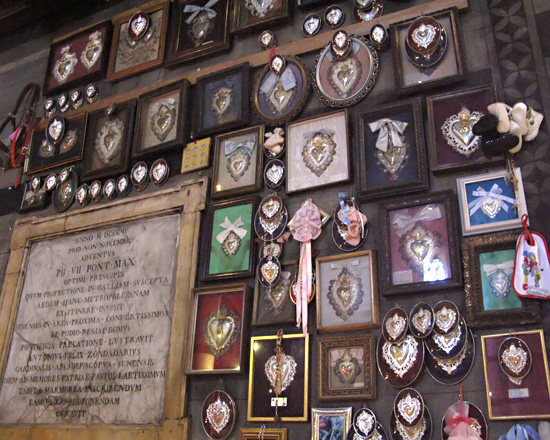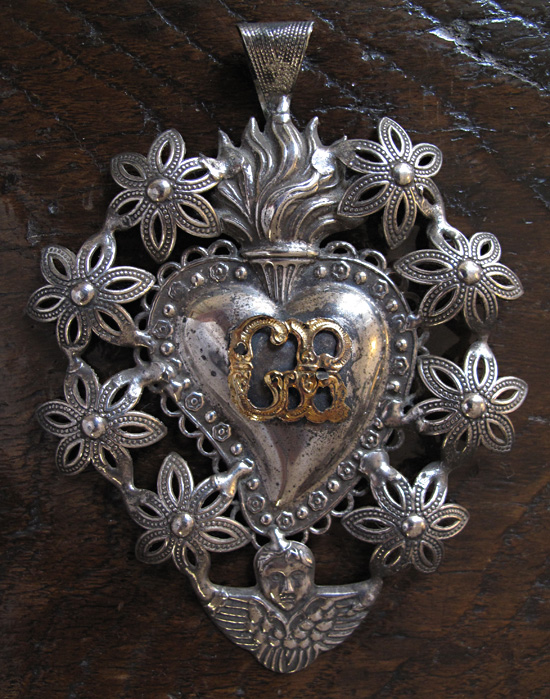Two years ago, in exploring one church after another, I noticed cathedral walls laden with silver framed medallions bearing the letters “GR”. Some were tied with a pink or a blue ribbon. There may have been 50 in some churches, or hundreds in others.
Here’s a wall in the Duomo of Sienna (from 2008).

With an interest in symbols and icons, silverwork and folk art, I was intrigued. What were these? What meaning did they hold to those that posted them?
In Firenze, I went into a store selling Catholic statues, vestments, rosaries and other religious items and talked to one of the nuns working there. She explained “Per Grazia Ricevuta” – “For Grace Received” – this physical symbol of gratitude. The medallions are placed in the cathedrals at the birth of a child, the healing of an illness or injury, or other instances of great grace. (I bought one for my brother to acknowledge him, his wife and 5 kids.)
Two years later, now back in Italy, I continue to see the Grazia Ricevuta medallion. It moves me that the Italians have this tangible symbol for their gratitude . (I rack my brain trying to think of an American corollary.)
– – –
I feel such deep gratitude for the opportunity to be here. I have the means and the fortitude to have come for a year even in the midst of global economic crisis. I have experienced no mishap, illness or calamity. I have remained safe both when traveling alone and riding my bike amidst crazy, Milanese traffic. My family, friends and clients back home have been supportive and steady. New friendships and chance meetings here have kept me from loneliness and given me the highlights of my time. I have seen things that have filled my head with images to last my lifetime. THIS has been a great grace received and I am genuinely humbled by the gift.
– – –
The Grazia Ricevuta has become increasingly touching to me as my time passes here in Milano. I purchased another framed medallion to hang in my home when I return. And I just purchased one (below) from the antique market which I will wear on occasion. When you see it, you will know its meaning to me.


That’s a beautiful practice. And what a lovely medallion.
I don’t think there’s anything comparable in the U.S. Perhaps Americans are too cynical and too proud of our sense of being independent? Of course, if there’s some way of finding profit in it by warping the meaning, then perhaps it would have a chance in the U.S. of A. I can see it now, Hallmark Happiness Medallions.
Actually, I think it’s more likely that the U.S. has such an array of beliefs that it is not unified to be able to arrive at such a custom.
Italy is about 90% Catholic and the church is strong in its influence in people’s life views and habits. With a “national religion” there can be national religious practices and traditions.
And speaking of cynicism, Gary…
I love the idea of a physical representation of a moment of grace. I had thought seriously about naming Brynn Grace. Its such a profound and important … experience, I guess. It seems like more than just a feeling. (However, Brynn does not have a Grace personality.)
My guess with Americans – we are so independent and self-reliant, we don’t learn to be grateful because we think we have to do it ourselves. And then we think we did do it ourselves, so – what need to be grateful? Not that I agree with this sentiment, but I think it is pervasive here.